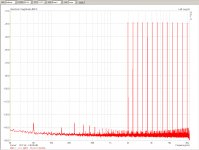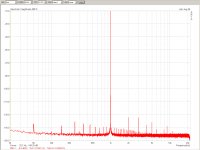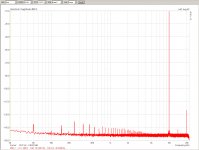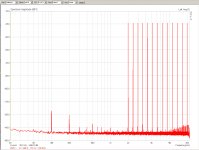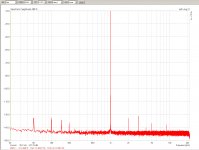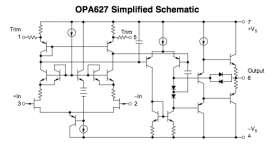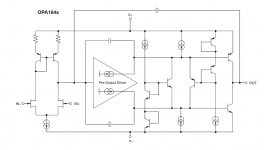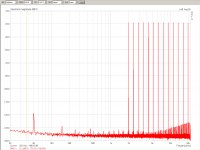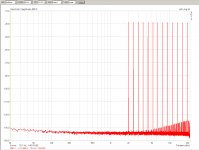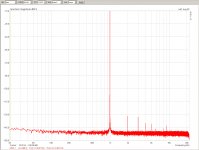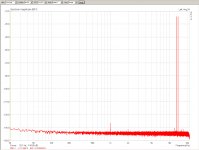So, with all this put forward, here are the diagrams with the AD797.
Firyst, the usual 1kHz test tone. Then the multitone test, which at one shot returns a lot of interesting aspects. All this in the test modul with external lab power supply.
Am I wrong or AD797 is doing worse than LM318?
Did you already posted ADA4627 and OPA827 measurements?
Inviato dal mio iPad utilizzando Tapatalk Pro
One can note a rise in the noise floor, in the low frequency range. Which is an interesting result, given that we are talking about one of the lowest noise high performance opamp.
Yes, but it's a bipolar opamp anyway. Very low en noise parameters with a legendary low 1/f noise corner, but mediocre in, input current noise parameters with much higher noise corner, so it start to rise visibly. Because we are 'abusing' this amp in this application, with very high input impedances presented to it's pins.
The not so exceptional high frequency distortion performance is just slightly surprising, the open loop gain has a very low corner frequency, though I expected a bit better behaviour. It can be me: given the bad 'fame' for happily oscillating, I had a havy hand in the compensations. Shall re-try this part.
All in all this is a good example to show that in comparison the LM318 is showing not a bad performance as well..
Yes, but it's a bipolar opamp anyway. Very low en noise parameters with a legendary low 1/f noise corner, but mediocre in, input current noise parameters with much higher noise corner, so it start to rise visibly. Because we are 'abusing' this amp in this application, with very high input impedances presented to it's pins.
The not so exceptional high frequency distortion performance is just slightly surprising, the open loop gain has a very low corner frequency, though I expected a bit better behaviour. It can be me: given the bad 'fame' for happily oscillating, I had a havy hand in the compensations. Shall re-try this part.
All in all this is a good example to show that in comparison the LM318 is showing not a bad performance as well..
Dario,
See my (contemporary) reply above.. 🙂
And yes, I have posted already both of them. Will report agin for easier comparison.
But wait, the nice part is missing!
See my (contemporary) reply above.. 🙂
And yes, I have posted already both of them. Will report agin for easier comparison.
But wait, the nice part is missing!
You maybe have hoted that I was talking about the OPA627 --- without facts.. very bad very bad..
So here they are, the tests on the actual amp which I have been listening to (with C9 shorted )
All I can say is wov.. Would like to repeat, without any kind of extra efforts to stabilize, any sufference.. The only sufference in the system is the close vicinity of a >400W power transformer, which is visible unfortunately.
So here they are, the tests on the actual amp which I have been listening to (with C9 shorted )
All I can say is wov.. Would like to repeat, without any kind of extra efforts to stabilize, any sufference.. The only sufference in the system is the close vicinity of a >400W power transformer, which is visible unfortunately.
Attachments
ADA4627
For comparison, here are the equivalent shots for the ADA4627.
For comparison, here are the equivalent shots for the ADA4627.
Attachments
-
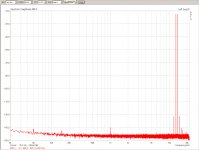 FE_ADA4627_-10db_44k_5W_13-14kHz_IMD_kulstap_10mF_28_jul_massa.jpg436.5 KB · Views: 108
FE_ADA4627_-10db_44k_5W_13-14kHz_IMD_kulstap_10mF_28_jul_massa.jpg436.5 KB · Views: 108 -
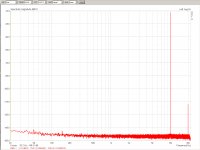 FE_ADA4627_-10db_44k_5W_10kHz_kulstap_10mF_28_jul_massa.jpg435.1 KB · Views: 106
FE_ADA4627_-10db_44k_5W_10kHz_kulstap_10mF_28_jul_massa.jpg435.1 KB · Views: 106 -
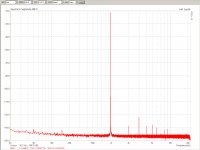 FE_ADA4627_-10db_44k_5W_1kHz_kulstap_10mF_28_jul_massa.jpg423.3 KB · Views: 439
FE_ADA4627_-10db_44k_5W_1kHz_kulstap_10mF_28_jul_massa.jpg423.3 KB · Views: 439 -
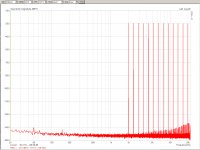 FE_ADA4627_-12db_44k_5W_high_multitone_kulsotap_10mF_26_jul_massa.jpg487.7 KB · Views: 452
FE_ADA4627_-12db_44k_5W_high_multitone_kulsotap_10mF_26_jul_massa.jpg487.7 KB · Views: 452
For completness, here are again the shots for the LME49990.
This seems to be the bipolar amp that can compete with the precision fet types, in this application. If only it would be less of a pain ITA..
This seems to be the bipolar amp that can compete with the precision fet types, in this application. If only it would be less of a pain ITA..
Attachments
No measurements for OPA827?
In other applications I prefer it over all the others you tried, by a not small margin.
Another very nice opamp to try is ADA4898-1, but maybe rails should be lowered with it.
Very similar to OPA827 in timbre but with added detail, cleaniness and linearity but a bit less emotion.
In other applications I prefer it over all the others you tried, by a not small margin.
Another very nice opamp to try is ADA4898-1, but maybe rails should be lowered with it.
Very similar to OPA827 in timbre but with added detail, cleaniness and linearity but a bit less emotion.
Dario,
I have already posted somewhere down in this thread the results with OPA827.
I will repeat the measurement, will have to take out my main amp.
Anyway, it's not the same performer, interestingly, and only in the light of these specific measurements. Also the OPA1641 (I have posted already the results with OPA1642, OPA140)
The best three are in the posts right above here.. OPA627 having the lead..
I had to go and re-buy the ADA4898-1. I have it now, will put in measurement soon.
Strange thing is that in a different application, in a AK4490 output stage, (as diff. amp) it was out performed so easily by the OPA1688 (also posted results here) that I have listened to it only for a short period. But really, there was no question about that time..
For this I had strong hopes in the OPA1688, as a possible candidate also for the Myref. Only to have a miserable failure in the listening tests. Very strange, my all time favorite dac-output-stage hero became the one and only, definit 'not recommended' part for this role in the Myref..
I think it has to do with the slew rate limits. While it is moderate (8V/us) for the OPA1688, the genius of Mauro had foreseen very well that in this composite application a faster control amp is needed. I have digged deeper into this, had spent some spicing time on this, and it is visible that the OPA1688 is not able to drive with equivalent dynamic precision the current buffer.
One can note that all the featured amps here are all >20MHz, between 20-150 V/usec, moderate noise and sometimes precision amps.
Ciao, George
I have already posted somewhere down in this thread the results with OPA827.
I will repeat the measurement, will have to take out my main amp.
Anyway, it's not the same performer, interestingly, and only in the light of these specific measurements. Also the OPA1641 (I have posted already the results with OPA1642, OPA140)
The best three are in the posts right above here.. OPA627 having the lead..
I had to go and re-buy the ADA4898-1. I have it now, will put in measurement soon.
Strange thing is that in a different application, in a AK4490 output stage, (as diff. amp) it was out performed so easily by the OPA1688 (also posted results here) that I have listened to it only for a short period. But really, there was no question about that time..
For this I had strong hopes in the OPA1688, as a possible candidate also for the Myref. Only to have a miserable failure in the listening tests. Very strange, my all time favorite dac-output-stage hero became the one and only, definit 'not recommended' part for this role in the Myref..
I think it has to do with the slew rate limits. While it is moderate (8V/us) for the OPA1688, the genius of Mauro had foreseen very well that in this composite application a faster control amp is needed. I have digged deeper into this, had spent some spicing time on this, and it is visible that the OPA1688 is not able to drive with equivalent dynamic precision the current buffer.
One can note that all the featured amps here are all >20MHz, between 20-150 V/usec, moderate noise and sometimes precision amps.
Ciao, George
This is an interesting discussion and well on topic for the FE. I have always been curious about the differences between op amps, beyond the simple JFET or Bi-Polar input.
Anyway, I got curious how the op amps discussed here are made differently. AD doesn't offer schematics in their datasheets, but TI does. So using the OPA1641 as the basic JFET input op amp and comparing it to the OPA827 and OPA627 shows some interesting differences.
The 1641 has a single complementary pair of JFET inputs tied to a pair of PNP bi-polars.
The 827 has parallel pairs of JFETs on the input driving parallel pairs of PNP Bi-polars.
The 627 has a pair of JFETS driving what looks to be a PNP buffer and a PNP driver.
I don't know enough about circuit design other than to say these are definitely different approaches, so maybe they should sound different. Take a look at the schematics below.
Anyway, I got curious how the op amps discussed here are made differently. AD doesn't offer schematics in their datasheets, but TI does. So using the OPA1641 as the basic JFET input op amp and comparing it to the OPA827 and OPA627 shows some interesting differences.
The 1641 has a single complementary pair of JFET inputs tied to a pair of PNP bi-polars.
The 827 has parallel pairs of JFETs on the input driving parallel pairs of PNP Bi-polars.
The 627 has a pair of JFETS driving what looks to be a PNP buffer and a PNP driver.
I don't know enough about circuit design other than to say these are definitely different approaches, so maybe they should sound different. Take a look at the schematics below.
Attachments
Hi All
I was seeing many good mods, lastly, for this wonderful amp...so, i'd like to let my contribution.
The Dario's Bom is perfect ( not only the Bom, clearly ), impossible to do better of it, he done a wonderful work tuning all components. The FE is another beast than original MyRef.
The only changes ( both expensive ) i've done was:
compensation caps (27pf/150pf/220pf/1000pf) and diodes
I used Glass Capacitor, Avx-Cornick
Not so simple to find, specially the right value, not so cheap to buy ( very expensive! ) but i liked very much! I use them in RIAA also .
High frequencies are a bit more "round", "sweet". Overall presentation is a bit more full, a bit more rich of harmonics.
Sometimes on eBay you can find them cheap, used, from England...
In a scale from 1 to 10, if Wima Fkp is 7
and the Amtrans are 8, the Glass caps are 9
So, they worth 4 time the price of Amtrans?
Dunno...It's a matter of tastes, a personal choice
I tried also SiC diode, and liked more than Mur 820/860
The sound is..., it's difficult to explain but there's difference for better IMHO
Price is 2/3 time Mur 860.
I have to try Nichicon 470uf from Dario's Bom, now I'm using BG Std 220/50 for C1/C2
I have already OpAmp to try (Opa 827- Ada 4627brz)
I will do and will report soon; get rid C9 was my dream from the start, so i buyed MyRef Evolution, but also the servo in the Evo was a solution not better of a well choose C9 IMHO
This design still reserve some surprises.
In the past i've tried 36V (12V x 3 per rail, total 6) Pb Batteries with LC filter... Heavy and bulky but i liked very much!
I'd like to try a well designed Regulated Power Supply
Ciao
Marco
I was seeing many good mods, lastly, for this wonderful amp...so, i'd like to let my contribution.
The Dario's Bom is perfect ( not only the Bom, clearly ), impossible to do better of it, he done a wonderful work tuning all components. The FE is another beast than original MyRef.
The only changes ( both expensive ) i've done was:
compensation caps (27pf/150pf/220pf/1000pf) and diodes
I used Glass Capacitor, Avx-Cornick
Not so simple to find, specially the right value, not so cheap to buy ( very expensive! ) but i liked very much! I use them in RIAA also .
High frequencies are a bit more "round", "sweet". Overall presentation is a bit more full, a bit more rich of harmonics.
Sometimes on eBay you can find them cheap, used, from England...
In a scale from 1 to 10, if Wima Fkp is 7
and the Amtrans are 8, the Glass caps are 9
So, they worth 4 time the price of Amtrans?
Dunno...It's a matter of tastes, a personal choice
I tried also SiC diode, and liked more than Mur 820/860
The sound is..., it's difficult to explain but there's difference for better IMHO
Price is 2/3 time Mur 860.
I have to try Nichicon 470uf from Dario's Bom, now I'm using BG Std 220/50 for C1/C2
I have already OpAmp to try (Opa 827- Ada 4627brz)
I will do and will report soon; get rid C9 was my dream from the start, so i buyed MyRef Evolution, but also the servo in the Evo was a solution not better of a well choose C9 IMHO
This design still reserve some surprises.
In the past i've tried 36V (12V x 3 per rail, total 6) Pb Batteries with LC filter... Heavy and bulky but i liked very much!
I'd like to try a well designed Regulated Power Supply
Ciao
Marco
Ciao Tutti,
Very nice, now we are talking! 🙂
Also: I'm happy to see You to pop up, Marco! I've heard from Dario about your tests in the past, and your Evo.. Hmm, undecent proposals might surface from my side, be prepared!
Dario was asking about the OPA827 tests: I dug it from my disk, honestly also me lost track where been shown here..
It's not bad but also not exceptional. With these measurements, should repeat. Which are aimed for tasking the 'processing power' of these units, like in brute force, gain bandwith or even better, bandwith of the first pole.
There are other points, about it later.
And I consider it very very good sounding in my amp, not by accident that it still stays there.
But, may I humbly suggest, Marco, that You could start with the ADA4627 chip?
Because for some obscure reasons I feel like Dario for sure will put the OPA827 in his module / modules...😀
And so You could directly compare the sound between you, like we are doing it here..
Very nice, now we are talking! 🙂
Also: I'm happy to see You to pop up, Marco! I've heard from Dario about your tests in the past, and your Evo.. Hmm, undecent proposals might surface from my side, be prepared!
Dario was asking about the OPA827 tests: I dug it from my disk, honestly also me lost track where been shown here..
It's not bad but also not exceptional. With these measurements, should repeat. Which are aimed for tasking the 'processing power' of these units, like in brute force, gain bandwith or even better, bandwith of the first pole.
There are other points, about it later.
And I consider it very very good sounding in my amp, not by accident that it still stays there.
But, may I humbly suggest, Marco, that You could start with the ADA4627 chip?
Because for some obscure reasons I feel like Dario for sure will put the OPA827 in his module / modules...😀
And so You could directly compare the sound between you, like we are doing it here..
Attachments
Last edited:
ADA4898
So I had the ADA4898 fit in the second test unit. Because in the other I still have the AD797. Of which I had revisited the compensation scheme, which had been overdone at first trial.
But no real change in the response, even with an optimised, close-to-minimal compensation this time. So it seems to be really the response of the AD797 itself, what had been shown earlier.
Finding an okey compensation for the ADA4898 was quite smooth, and here it is the result:
So I had the ADA4898 fit in the second test unit. Because in the other I still have the AD797. Of which I had revisited the compensation scheme, which had been overdone at first trial.
But no real change in the response, even with an optimised, close-to-minimal compensation this time. So it seems to be really the response of the AD797 itself, what had been shown earlier.
Finding an okey compensation for the ADA4898 was quite smooth, and here it is the result:
Attachments
Last edited:
Yes..🙂
And 500VA, this time.. the OPA827 sits in my EVO amp, with a 500VA Talema transformer, touching / sitting on the edge of the printed circuit board..
May I grab the occasion, touting qualities of the device under test: Who of You had noticed distortion level changes (not hum contribution) in measurements between modules off the lab supply or the real full power supply? (Unregulated, transformer+rectifier+filter caps)
Also, for fun here it is again my favorite, a comparison of test methods: the multitone test done in a 'zero stress mode' like it could be seen at some other place.
And a real one, the high frequency intermodulation for the module, always with the ADA4898:
And 500VA, this time.. the OPA827 sits in my EVO amp, with a 500VA Talema transformer, touching / sitting on the edge of the printed circuit board..
May I grab the occasion, touting qualities of the device under test: Who of You had noticed distortion level changes (not hum contribution) in measurements between modules off the lab supply or the real full power supply? (Unregulated, transformer+rectifier+filter caps)
Also, for fun here it is again my favorite, a comparison of test methods: the multitone test done in a 'zero stress mode' like it could be seen at some other place.
And a real one, the high frequency intermodulation for the module, always with the ADA4898:
Attachments
Last edited:
I don't know enough about circuit design other than to say these are definitely different approaches, so maybe they should sound different. Take a look at the schematics below.
Jac,
Also: if you take a look of the datasheet of the OPA211/1611 full bipolar (SiGe) family, you might note some nice similarities.. (to the 1641)
Then: shooting from hip: ADA4898 (high voltage SiGe bipolar) is probably the same design line at AD, that the OPA1611 /211 for TI.
OPA 627 is a bit older, from before the SiGe 'revolution', but was the luxury, expensive dielectric-isolation fet-bjt technology of yesteryear. The input devices have much less capacitance change with tension, and so less capacitive distortion.
And I don't know nothing too. But there are people who do, and are a treasure to follow:
http://www.diyaudio.com/forums/everything-else/169484-what-wrong-op-amps-122.html#post4845064
Ciao! G
Hi Joseph
Thank you for your welcome 🙂
I can do test with Evo and FE, so I can compare real time the OpAmp, because both have same components (almost) Mundorf/Zfoil/Caddock , only big difference is in C1/C2 where i used Elna longlife because Evo don't have room for BG or other Caps
And compensation caps are PPS because there are not glass caps in surface mount
I know well the preference for 827 from Dario, i used them in Evo instead of TL071 ( servo ) behind his suggestion
I like Ada 4627, i preferred them over 627 in my phonoclone
Hope to do OpAmp test soon
Ciao
Marco
Thank you for your welcome 🙂
I can do test with Evo and FE, so I can compare real time the OpAmp, because both have same components (almost) Mundorf/Zfoil/Caddock , only big difference is in C1/C2 where i used Elna longlife because Evo don't have room for BG or other Caps
And compensation caps are PPS because there are not glass caps in surface mount
I know well the preference for 827 from Dario, i used them in Evo instead of TL071 ( servo ) behind his suggestion
I like Ada 4627, i preferred them over 627 in my phonoclone
Hope to do OpAmp test soon
Ciao
Marco
Marco,
So, You already have an 827 in your amp, only in the wrong place 😉
It's just a quick swap.. in the main position.. and a swap for zero, nothing in the servo.
And the dinner is ready for consumption!
(Joking, you should be careful, in reality!!)
Ps:
" because both have same components (almost) Mundorf/Zfoil/Caddock"
Really? Did you install Zfoils in the feedback in the EVO? (both places)
I'm asking because I did, and that is important.
It's smd sculpture technology, but rewarding.
Also the servo integrator capacitor, that is a perfect place for a Pana PPS (ECHU), some uF..
for these last hours of use of the servo 🙂
Ciao! G
So, You already have an 827 in your amp, only in the wrong place 😉
It's just a quick swap.. in the main position.. and a swap for zero, nothing in the servo.
And the dinner is ready for consumption!
(Joking, you should be careful, in reality!!)
Ps:
" because both have same components (almost) Mundorf/Zfoil/Caddock"
Really? Did you install Zfoils in the feedback in the EVO? (both places)
I'm asking because I did, and that is important.
It's smd sculpture technology, but rewarding.
Also the servo integrator capacitor, that is a perfect place for a Pana PPS (ECHU), some uF..
for these last hours of use of the servo 🙂
Ciao! G
Last edited:
Joseph
Yesss, you've right 🙂
Hope the Board don't suffer for desoldering, I've read your warning
Ciao
Marco
Yesss, you've right 🙂
Hope the Board don't suffer for desoldering, I've read your warning
Ciao
Marco
Wow guys, I haven't still completed mine and you are making me wanting some mods..!
Inviato dal mio D5803 utilizzando Tapatalk
Inviato dal mio D5803 utilizzando Tapatalk
Marco, now seriously: desoldering the parts from the EVO is not the same that in case of the FE of Dario (as you know, I immagine)
The pcb is fragile, so consult with Dario or me (I have the right tools, hope also Dario) before acting up.
Dario's board is a feat of robust engineering: I've lost the counts how many times I have desoldered the chips -- still a vigorous, healthy look..
Just saying
Ghiglie, haha 🙂
The pcb is fragile, so consult with Dario or me (I have the right tools, hope also Dario) before acting up.
Dario's board is a feat of robust engineering: I've lost the counts how many times I have desoldered the chips -- still a vigorous, healthy look..
Just saying

Ghiglie, haha 🙂
Last edited:
- Home
- Amplifiers
- Chip Amps
- My_Ref Fremen Edition - Build thread and tutorial
